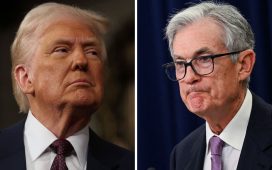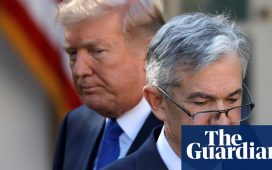Unlock the Editor’s Digest for free
Roula Khalaf, Editor of the FT, selects her favourite stories in this weekly newsletter.
US stocks have registered their best week in a year, with a big slowdown in hirings reported on Friday fuelling investor expectations that interest rates have peaked.
American employers created 150,000 new jobs last month — fewer than forecast and barely half of September’s revised figure of 297,000. Economists surveyed by Bloomberg had expected a total of 180,000 new posts for October.
The numbers provided further power to a rally in stocks as well as US Treasuries, as investors bet that the slowdown in the labour market made it more likely that the Federal Reserve will not raise rates further in the coming months.
The blue-chip S&P 500 stock index closed up 0.9 per cent on the day, and 5.9 per cent since last Friday, for its best week since early November 2022.
The yield on the two-year US Treasury note, which moves inversely to price and tracks rate expectations, dropped to a two-month low of 4.81 per cent following the jobs data. Yields on 10-year notes dipped below 4.5 per cent for the first time in a month.
The bond market had previously strengthened this week on the back of comments by Fed chief Jay Powell that the central bank was “proceeding carefully” with future rate rises. Some investors have taken those remarks as a sign that higher borrowing costs have already sufficiently slowed down the US economy.
Michael Feroli at JPMorgan said the jobs report “seemed tailor-made” to match the Fed’s message that the US was on course for a soft economic landing, as the central bank seeks to bring inflation back to its 2 per cent target. Inflation, which surpassed 9 per cent at its peak last year, is now 3.7 per cent.
Feroli added that, while some aspects of the report “hint at a harder landing to come”, including fewer industries in which employment is growing, at present the data “looks like Goldilocks”.
Jobs growth is an important indicator for investors and Fed rate-setters, who monitor the labour market for evidence that the central bank’s tightening campaign is cooling the economy.
Trading in interest rate futures after the jobs data signalled that investors now expect a quarter-point US rate cut in June, compared with previous expectations of a cut in July. Traders also pulled back further from any expectation of a further rate rise this year.
“This jobs report is . . . helping convince non-believers that this is very much the end of the rate hike cycle,” said Kristina Hooper, chief global markets strategist at Invesco. “We are very much in a disinflationary trend, the economy is cooling and the Fed does not have to hike rates again.”
But Thomas Barkin, president of the Richmond Fed, told CNBC on Friday that it was not yet clear if interest rates had peaked, adding that the timing of potential rate cuts was “still a ways off in my mind”.
US president Joe Biden gave an upbeat response to the labour figures, highlighting that unemployment had remained below 4 per cent for 21 consecutive months, the longest stretch in more than 50 years.
According to the Bureau of Labor Statistics data, the US unemployment rate rose to 3.9 per cent in October, from 3.8 per cent in September. Average earnings edged 0.2 per cent higher, a slight slowdown from the 0.3 per cent increase in the previous month.
Economists said strike action by autoworkers had probably reduced October’s headline figure for new jobs by about 30,000 — but that underlying data still indicated that hiring had slowed.
The August figure for new jobs was also revised downwards by 62,000 to 165,000.
In other figures published on Friday, the US services sector also grew more slowly than forecast last month.
The Fed, which kept rates on hold on Wednesday, had previously raised them from near zero in March last year to a target range of 5.25 per cent to 5.5 per cent.
With investor confidence growing that other big central banks also appear to have finished raising interest rates, Europe’s region-wide Stoxx 600 finished the week up 3.2 per cent.
In London, the FTSE 100 rose 1.7 per cent for the week, helped by a rise in interest rate-sensitive real estate stocks following the Bank of England’s decision on Thursday to leave rates unchanged.
Steve Sosnick, chief market strategist at Interactive Brokers, said equity markets were “hyper sensitive to any whiff” that central bank policy would be less tight than previously thought.
He added that, while stock markets could react slowly to restrictive moves by central banks, they often responded quickly to a looser stance because it implied that funding would soon get cheaper.
Additional reporting by Kate Duguid and George Steer










